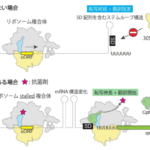メンケス病などの銅欠乏症の治療に役立つと期待される発見 Discovery will help in treating Menkes disease, other copper deficiency disorders
2023-03-24 テキサス A&M大学
研究者らは、この問題を解決するため、細胞内でelesclomolが銅を放出し、他の銅薬剤とは異なる機能を果たすことを明らかにした。FDX1というミトコンドリア酵素がelesclomolのターゲットであり、彼らはこの酵素がelesclomolが運ぶ銅を放出するメカニズムを発見した。この研究結果は、今後銅欠乏症の治療法開発に貢献する可能性がある。
<関連情報>
- https://agrilifetoday.tamu.edu/2023/03/24/study-uncovers-a-unique-efficient-method-of-copper-delivery-in-cells/
- https://www.pnas.org/doi/10.1073/pnas.2216722120
エレスクロモールを介した細胞内銅輸送のFDX1依存および独立メカニズム FDX1-dependent and independent mechanisms of elesclomol-mediated intracellular copper delivery
Mohammad Zulkifli ,Amy N. Spelbring,Yuteng Zhang ,Shivatheja Soma ,Si Chen,Luxi Li,Trung Le ,Vinit Shanbhag,Michael J. Petris,Tai-Yen Chen ,Martina Ralle ,David P. Barondeau ,Vishal M. Gohil
Proceedings of the National Academy of Sciences Published:February 27, 2023
DOI:https://doi.org/10.1073/pnas.2216722120

Significance
Genetic defects in copper transport to cuproenzymes result in infantile disorders for which no effective therapies are currently available. Recent studies have uncovered the therapeutic potential of elesclomol, a copper-transporting drug, in the treatment of copper deficiency disorders. To realize the full potential of this drug, it is necessary to gain a mechanistic understanding of how elesclomol makes copper available to different cellular cuproenzymes. Here, we demonstrate that copper is released from elesclomol within mitochondria via FDX1, and outside of mitochondria in an FDX1-independent manner to make copper available to mitochondrial and nonmitochondrial cuproenzymes, respectively. These modes of copper release are distinct from other currently used copper-transporting drugs and may explain the high potency of elesclomol in rectifying copper deficiency.
Abstract
Recent studies have uncovered the therapeutic potential of elesclomol (ES), a copper-ionophore, for copper deficiency disorders. However, we currently do not understand the mechanism by which copper brought into cells as ES–Cu(II) is released and delivered to cuproenzymes present in different subcellular compartments. Here, we have utilized a combination of genetic, biochemical, and cell-biological approaches to demonstrate that intracellular release of copper from ES occurs inside and outside of mitochondria. The mitochondrial matrix reductase, FDX1, catalyzes the reduction of ES–Cu(II) to Cu(I), releasing it into mitochondria where it is bioavailable for the metalation of mitochondrial cuproenzyme— cytochrome c oxidase. Consistently, ES fails to rescue cytochrome c oxidase abundance and activity in copper-deficient cells lacking FDX1. In the absence of FDX1, the ES-dependent increase in cellular copper is attenuated but not abolished. Thus, ES-mediated copper delivery to nonmitochondrial cuproproteins continues even in the absence of FDX1, suggesting alternate mechanism(s) of copper release. Importantly, we demonstrate that this mechanism of copper transport by ES is distinct from other clinically used copper-transporting drugs. Our study uncovers a unique mode of intracellular copper delivery by ES and may further aid in repurposing this anticancer drug for copper deficiency disorders.


